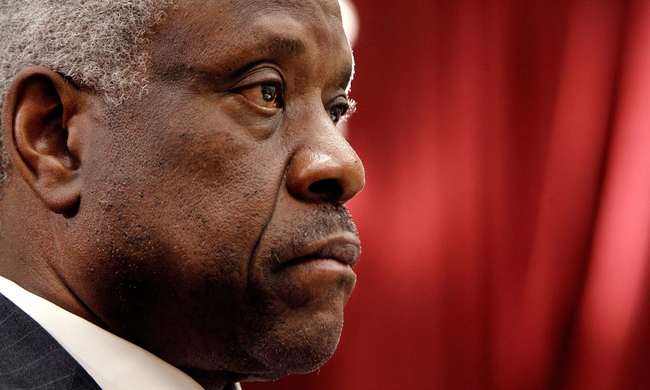Above: Justice Clarence Thomas announced the court’s decision.
There is both good news and bad news in the Supreme Court’s Jun. 13 decision in Vidal v. Elster. A piece of good news is that the court reached the right result. Another bit of good news is that it rejected the “interest-balancing” invented by the court’s 20th century liberal majorities.
A piece of bad news is that the court relied on the wrong part of the First Amendment. Another is that the court extended its use of history too far.
The Facts
Steve Elster decided to join the crowd in abusing the legal system to harass former President Donald Trump. Elster created a trademark using Trump’s name in a vulgar and derogatory way. State law allowed him to do so.
Elster also wanted to register his trademark with the federal government, not because it was required but because legal benefits accompany federal registration. However, the U.S. Patent and Trademark Office turned down his application. It did so was because the “names clause” of the Lanham Act does not allow a person to federally register a living person’s name without that person’s consent.
Elster claimed the “names clause” violates the First Amendment’s free speech guarantee. Although he lost at the Trademark Trial and Appeal Board, he won in the U.S. Court of Appeals. The Supreme Court agreed to review the case.
The Supreme Court’s Ruling
Justice Clarence Thomas announced the court’s conclusion: The “names clause” did not violate the First Amendment’s protection of what it calls “the freedom of speech.” All the justices agreed with this conclusion.
But only five of the nine agreed with the core of Justice Thomas’ reasoning. The nine issued four different opinions. And they played musical chairs as to which part of which opinions they joined.
The reasoning that won a bare majority went something like this:
- The “names clause” does not discriminate for or against any particular viewpoint;
- it does discriminate on the basis of content, because it prohibits you from registering a trademark that includes a living person’s name without that person’s consent; and
- although some previous “content-based” decisions have applied “means-ends analysis” and “interest balancing,” the court wouldn’t do so here. This was because the long history of trademark regulation showed that the “names clause” posed no threat to free speech.
“Means-Ends Analysis” and “Interest Balancing”
What did the court mean by “means-ends analysis” and “interest balancing?”
Throughout most of the 20th century, the court was dominated by liberal or progressive majorities. Generally speaking, liberal justices did not inquire into the language and background of the Constitution’s guaranteed rights. Instead, they created their own legal code.
The liberal jurists’ code played favorites among rights by elevating some above others. It decided that some reasons for government suppression were more important than others. Applying this code involved “means-ends analysis” and “interest balancing.”*
In some respects, this legal code looked more like the liberal political program than the actual meaning of the Constitution. Freedoms valued by thrifty, diligent, and pious Americans often were subordinated to “rights” to engage in aberrant and disruptive behavior. For example, the right of employers and employees to agree on the terms of employment was granted less protection than the “right” of state universities to play racial politics.
In 2008, the Supreme Court decided District of Columbia v. Heller. This case ruled that the Second Amendment—which had been largely ignored by the 20th century progressive majorities—protected an individual’s right to keep and bear arms. In applying Heller, though, the lower federal courts began to use “means-ends analysis” and “interest balancing.”
In 2022, the Supreme Court issued New York State Rifle and Pistol Ass’n v. Bruen. Speaking through Justice Thomas, the court announced that it would not clutter the Second Amendment with “means-ends analysis” and “interest balancing.” The court said that judges should interpret the Second Amendment according to its words, as those words were understood by the Founders. If some aspect of the amendment was unclear, then judges should do what they usually do when a document’s words are unclear: Examine the surrounding circumstances.
Examining the surrounding circumstances required focusing on the history relevant to the Constitution’s adoption. This included events during the Founding-Era, including the Founders’ understanding of earlier developments.
What the Court Did in Vidal v. Elster
In Vidal v. Elster, the court announced that it would not use means-ends analysis and interest balancing in the case, because history showed that the “names clause” of the Lanham Act was fully consistent with free speech.
But the court examined not merely the history relevant to the Founding, but 19th and even 20th century history as well. Its reason was that trademark law was not well developed when the First Amendment was adopted in 1791.
Several other members of the court thought that this sweeping use of history was excessive. Justice Amy Coney Barrett observed that “The Court does not (and could not) argue that the late 19th and early-20th century . . . tradition serves as evidence of the original meaning of the Free Speech Clause.” And Justice Sonia Sotomayor wrote:
“To borrow Justice Scalia’s criticism from a different context, such hunting ‘far into the dimmy past’ is not just “a waste of research time and ink” but also “a false and disruptive lesson in the law . . . that . . . condemns litigants (who, unlike us, must pay for it out of their own pockets) to subsidizing historical research by lawyers.”
Where the Court Erred
The court reached the right conclusion, and it correctly rejected means-ends analysis and interest balancing. But it erred in two ways.
One mistake was getting the First Amendment issue wrong. The correct question was not whether the “names clause” violates the freedom of speech. The correct issue was whether it violates freedom of the press.
As I explained in a 2015 research article and in my book “The Original Constitution,” the First Amendment phrase “the freedom of speech,” refers to direct in-person communication. But the phrase “the freedom . . . of the press” means communication through a written (or broadcast) medium. Trademarks are in the latter category.
Freedom of speech and freedom of the press are closely related, but the founding generation acknowledged that their limits are not quite the same. Moreover, we have more and better historical information on the limits of freedom of the press than of freedom of speech.
The court’s second mistake was relying on 19th and 20th century history. As Justice Barrett observed, that history could have had no influence on the meaning of the First Amendment. And as Justice Sotomayor pointed out, judges are not historians. They are much more likely to make mistakes when they sweep over centuries than when they focus their investigation on the Founding Era.
Moreover, history extending over centuries is more difficult for anyone to analyze than history focusing on a particular period—especially a period well-known to competent constitutional experts.
Twentieth century liberal justices’ “Due Process” cases further show the risk when judges range over the centuries. Those cases purportedly depended partly on whether practices were “deeply rooted in the Nation’s history and traditions.”
This approach proved to be worthless. The history contained so much material that judges could cherry-pick or manipulate it at will. One example: Roe v. Wade’s ruling that there was a constitutional right to abortion was based on two completely incompetent “historical” surveys written by a non-historian who also happened to be a pro-abortion activist.
How Vidal v. Ester Should Have Been Decided
Although the court reached the right result in Vidal v. Ester, its opinion should have been much shorter.
Initially, the court should have recognized that the correct issue was whether the “names clause” violated the First Amendment guarantee of freedom of the press.
Then the court should have acknowledged that when the First Amendment was adopted, the law protected people from having their names and reputations commandeered without their consent. No one thought that such commandeering was part of freedom of the press.
On the contrary, if you tried to commandeer another person’s name or reputation, you could end up (1) paying damages for fraud, (2) paying damages (or even suffering imprisonment) for libel, and/or (3) in some states, being challenged to a duel. Benjamin Franklin proposed another physical restriction on such conduct: “The liberty of the Cudgel.”
It follows that a statute protecting people against appropriation of their names and reputations merely incorporates a Founding-Era protection and does not violate the freedom of the press. End of case.
* * *
* The Constitution authorizes some judicial balancing tests—for example, the Fourth Amendment’s ban on “unreasonable” searches—but the 20th century courts applied them even when the Constitution did not authorize them.








